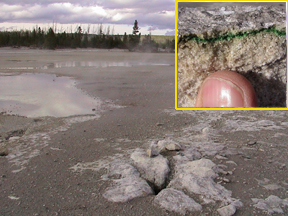 In the search
for life on other planets, researchers often turn their attention to Earth to
see what might thrive in environments not immediately recognizable as life-sustaining.
One such location is Yellowstone National Park, where magma beneath the caldera
creates a world of boiling acidic springs and steaming geysers. In Yellowstone’s
Norris Geyser Basin, researchers recently found an odd microbial community living
in the hot pore space of rocks — a discovery that could have implications
for finding life, or traces of ancient life, on Mars.
In the search
for life on other planets, researchers often turn their attention to Earth to
see what might thrive in environments not immediately recognizable as life-sustaining.
One such location is Yellowstone National Park, where magma beneath the caldera
creates a world of boiling acidic springs and steaming geysers. In Yellowstone’s
Norris Geyser Basin, researchers recently found an odd microbial community living
in the hot pore space of rocks — a discovery that could have implications
for finding life, or traces of ancient life, on Mars.Researchers recently found in Yellowstone National Park what could provide clues to finding life on other planets: a thin layer of living and fossilized microbes just beneath a rock’s surface. The microbial communities — the green band in the inset picture — thrive in the high temperatures and highly acidic waters of the Norris Geyser Basin. Courtesy of the University of Colorado, Boulder.
“Everyone in astrobiology who is looking at microbes in extreme environments on Earth is looking for biosignatures — a foolproof way of telling if there is life on other planets,” says Jan Amend of Washington University in St. Louis, Mo. Biosignatures indicate the presence of life in the past or present, including fossils or certain chemicals that could only be made by life forms. Jeffrey Walker was in Norris doing research on another topic when he accidentally cracked open a rock and found “a cool green layer about a centimeter below the rock’s surface,” says Norman Pace, his advisor at the University of Colorado, Boulder. Walker, Pace and colleague John Spear took the rock back to the lab, measured the green layer and “dug out the green stuff” to isolate its DNA.
Among their finds was a 0.75-centimeter-thick layer of microbes about 1.5 centimeters below the rock’s precipitated siliceous surface, as reported in the April 21 Nature. They also found that the upper contact between the microbial community and the siliceous outer layer of the rock is marked by fossilized filament casts of the microbes — the first such finding. These fossils, if found on other planets, would indicate life had been there, Pace says.
Amend, however, says he is not convinced that the “apparent microbial fossils” will ever be sufficient as biosignatures on extraterrestrial planets. “Now, if we could crack open a rock on Mars and find DNA, I think everyone would agree that we found life,” he says, but that’s not likely to happen. Before researchers will be able to know how to find life on other planets, they need to know the energy sources for the organisms, he says, whether it be photosynthesis or some other process. At Norris, the team reported, a combination of photosynthesis and some nonphotosynthetic process is likely driving the newly discovered microbial community.
Of the 40 different types of microbes Pace and his team say they discovered in the one rock, the most surprising was a type of mycobacteria. Known as causes of tuberculosis and leprosy, mycobacteria are usually found in acidic environments, but not in extremely acidic environments like this spring, which has a pH of 1 (acidic enough to quickly dissolve iron nails). In the sample the team collected, mycobacteria represented 30 percent of the community, Pace says, many thousand times the concentration that is usually found within a microbial community.
The researchers are not sure what causes the spike in mycobacteria, nor how the microbes are surviving. There’s a lot more work to be done, Pace says, both to understand these microbes and their place in the search for life in the universe.
Megan Sever

